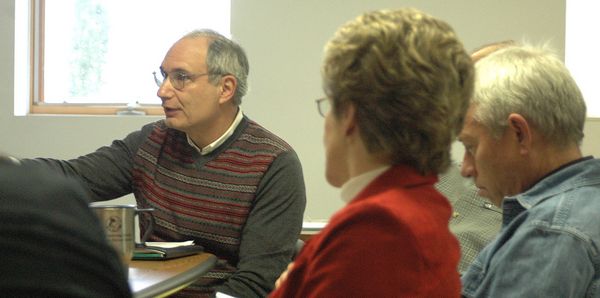Subscriptions
Menu
Advertisements
Village, CPI work toward common ground
12/12/2007 |
By Patsy Nicosia |

Hoping to jumpstart both the quick-hits and the longterm goals of year-old Hyett Palma report, members of the Cobleskill Partnership sat down with the Village of Cobleskill Saturday to touch base—and try to way for both to forge ahead, together, on revitalizing downtown Cobleskill.
That job, CPI argued, will require hiring help, a step the village seemed reluctant to take, even as both agreed the study won’t be worth the paper it’s written on if it just sits on the shelf.
“From my own perspective, there have been three studies like this that I can remember,” said Jim Poole , Times-Journal publisher. “This is our best chance…The public isn’t going to buy into another.”
Despite its shortcomings, Mayor Mike Sellers agreed the Hyett Palma study is valuable. He said his problem with the process has been not knowing who to deal with at CPI after Mark Eamer had to step back as president.
And though he said he’ll always reject the study’s recommendation that village offices be brought back downtown as “something we simply can’t afford,” Trustee Mark Galasso said he’s certain “the bulk of this can be accomplished.”
“This” includes such quick-hits as seeking funds to create a façade grant program, placing a community announcement board in Centre Park, and changing village policy to a 50-50 match for sidewalk costs to the intermediate steps of developing a strategy to deal with neglected properties and hiring a landscape architect to develop guidelines for buildings in the target area.
Hiring an economic development officer is also on that “intermediate” list, and though no one from the village board spoke against it, no one came out strongly in favor of it, either; Mr.Galasso said he’d rather see the job done by volunteers like this sitting at Saturday’s table, himself included.
Mayor Sellers spoke to the difficulty of planning for longterm projects with a budget that runs year-to-year and Deputy Mayor Sandy MacKay said even the simplest project—new sidewalks—becomes complicated when you start looking at the cost of badly-needed repairs to the water mains beneath the walks.
Mayor Sellers said he plans to create a five-year capital improvement program when he submits his 2008 budget, but “Right now, we’re not set up to plan for these things.”
CPI’s Jacqui Hauser said it might be easier to sell the cost of longterm plans to the public if they were packaged with something else like a façade grant program.
That idea, however, hit another wall when Trustee and former mayor Bill Gilmore pointed out the village has to be very careful about using public money on private properties, but offered to research it.
“I wouldn’t want that target on my forehead,” said Mr. Galasso.
Tax credits for improved properties are one alternative that might work, he said, but others warned against just moving money around.
That, CPI countered, isn’t their goal.
“I don’t need a beautiful downtown with no businesses in it,” said Ms. Hauser. “The object is to bring more people into downtown. If you have a downtown that’s producing revenue for business owners, they’ll pay your taxes.”
Donna Lavigne, another CPI member and a Main Street business owner, asked if the village planned ahead for the cost of implementing any recommendations when it paid for the Hyett Palma study, and CPI’s Brian Kaiser echoed that question.
“Where is an investment going to be made in a resource to implement these ideas?” he asked. “The study cannot be the goal.”
Putting the village on the spot, he asked if they’d consider paying for a full- or part-time person to do just that.
No one said no—or yes--but there was some interest in trying to write a grant for the position.
With not a lot decided, the village and CPI agreed to continue sitting down together and will meet again after mid-January. CPI will also start providing “department reports” at the village’s monthly meetings.
“I know we’re all meeting-ed out, but this can’t be the end of the process,” said Mr. Kaiser.









